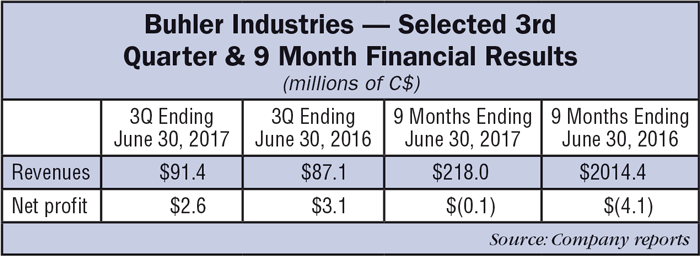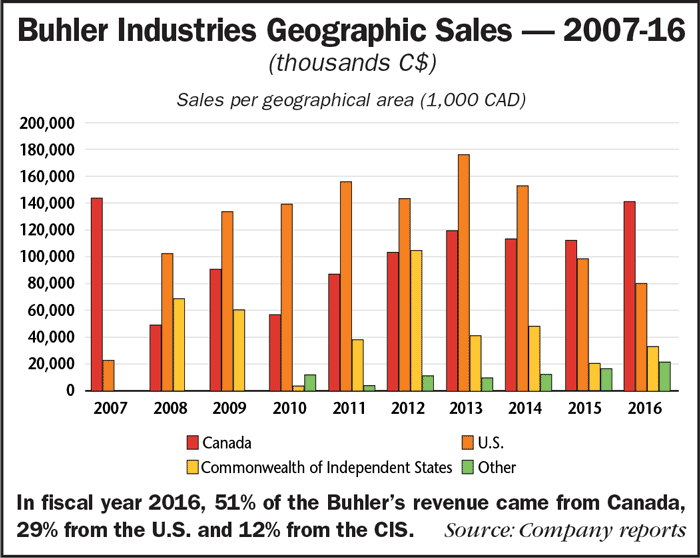Buhler Industries has come a long way since being acquired by Russian manufacturer Combine Factory Rostselmash Ltd. in 2007. It established early on that its intent was to become a full line manufacturer of farm machinery. Today, the company offers an extensive line of farm equipment, including Versatile, Allied and Farm King-branded machines.
On Aug. 14, the company reported its third quarter 2017 revenues increased to $91.4 million, up $4.3 million (4.9%) from the prior year third quarter. Revenue for the first 9 months of 2017 was $218 million, up $13.6 million from the same period of 2016. The Winnipeg, Man.-based company said, “Orders in North America have returned to near historic levels, with the company seeing an increase in sales to the U.S. Sales to Eastern Europe have remained steady.”

Net earnings of $2.6 million were down from $3.1 million for the third quarter of 2016. Year-to-date net earnings were down by $100,000 million, an improvement of down $4 million from the prior year. Contributing to the decreased earnings for the quarter was a $2.4 million gain on sale of surplus property in the prior year, offset by the current quarter’s improved margin. For the year to date, the increase is principally due to the improved margin, offset by increased gains on sale of surplus property in the prior year.
How Buhler Has Evolved
An analysis by Johan Wigert published in Seeking Alpha took a look at Buhler’s performance since it was acquired by Combine Factory Rostselmash Ltd. in 2007. The company was originally established under the name Standard Gas Engine Works in 1932 as an agricultural equipment manufacturer. John Buhler acquired the firm in 1969 and changed its name to Buhler Industries. The company began trading on the Toronto Stock Exchange in 1994 (TSX:BUI).
In 2007, Rostselmash, a combine manufacturer located in Russia, acquired 80% of the shares of Buhler. Rostselmash, says it produces over 17% of the total world production of combines. The two companies work independently of each other, but there are some synergies between them where Rostselmash buys technology from Buhler for tractors used in the Eastern European market. The Rostselmash dealer network also adds more than 200 dealers in Russia, Ukraine and Kazakhstan, through which Buhler Industries’ products are sold. Approximately 1,300 active dealers sell Buhler products throughout Canada and the U.S.
In fiscal year 2016, 51% of the revenue came from Canada, 29% from the U.S., and 12% from the Commonwealth of Independent States (mainly Russia, Ukraine and Kazakhstan). In the most recent quarter, U.S. sales were almost as high as Canadian sales. Revenue from the top two customers in 2016 was $30.2 million and $29.4 million. “Customer concentration risk doesn’t seem to be a major concern,” says Wigert. “The sales per geographical area has varied substantially between the years, where especially the U.S. and the Commonwealth of Independent States saw steep declines in 2015 and 2016.”

According to Wigert, the company has not focused on maximizing its profits during the last decade, but has rather followed a strategy to become an international player with a full line of products for large farm operations. Reinvestments in the business have led to a compounded annual growth rate of tangible book value of about 6.5% for the last 10 years.
Since its acquisition by Rostselmash, Buhler has made significant additions to it portfolio of farm machinery. Among these were Redball (Willmar, Minn.), Feterl Mfg. (Salem, S.D.) and Ezee-On (Vegreville, Alb.). Today, the company operates 9 manufacturing facilities and employs nearly 900 people.
Bouncing Back
The years 2015 and 2016 were characterized by one of the deepest drops in the global agriculture machinery market in recent history, which led to losses for the company in both years.
“The numbers for third quarter 2017 are the strongest third quarter numbers since 2013 after adjusting for a large gain on sale of surplus assets in 2016,” said Wigert. “The improvement was mainly driven by improved efficiencies in manufacturing and an increase in sales to the U.S. Significant improvements were made in supply chain management controls, which resulted in an inventory reduction of 29% or $60 million from 2015 to 2016.”
Looking Forward
Sales for 2017 are expected to be up over 2016 sales. While demand for agricultural equipment continues to be slow resulting from lower commodity prices, the company has experienced higher levels of demand for equipment in 2017 compared to 2016. Dealer inventory levels for front-wheel assist and 4WD tractors are down from last year in both Canada and the U.S., which will create opportunities when demand for new equipment increases. Subsequent to quarter end, the company finalized a 3 year asset-based lending agreement with CIBC, which will provide the company with a $50 million credit line and help reduce interest costs going forward. Profit margins are still expected to be soft due to competition for equipment sales and the weaker Canadian dollar that continues to have a significant negative impact on the company with parts purchased in U.S. dollars.






